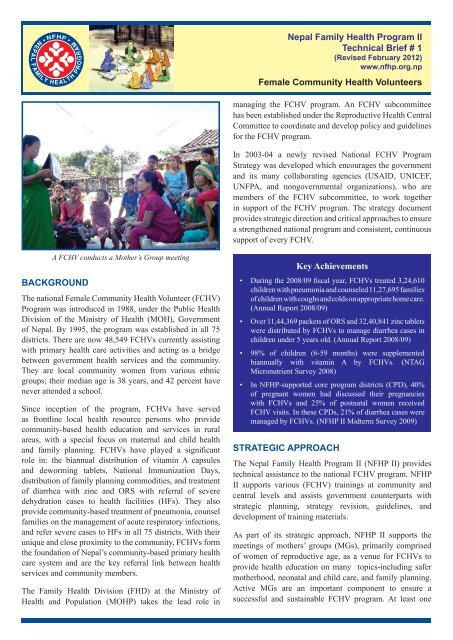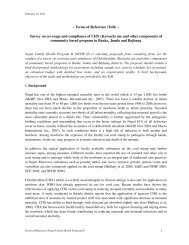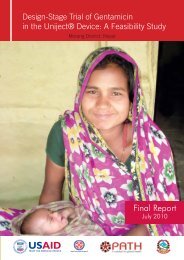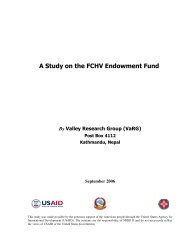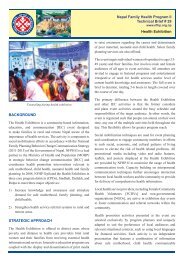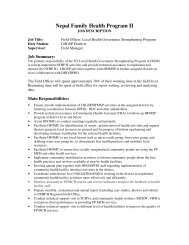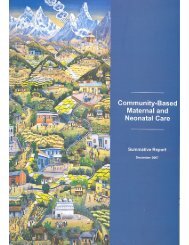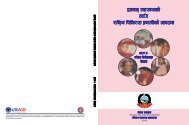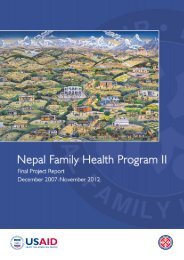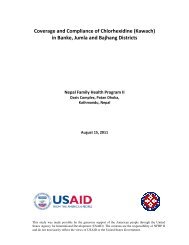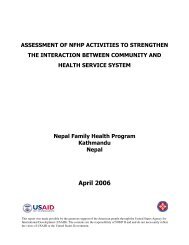Female Community Health Volunteers - Nepal Family Health ...
Female Community Health Volunteers - Nepal Family Health ...
Female Community Health Volunteers - Nepal Family Health ...
You also want an ePaper? Increase the reach of your titles
YUMPU automatically turns print PDFs into web optimized ePapers that Google loves.
<strong>Nepal</strong> <strong>Family</strong> <strong>Health</strong> Program II<br />
Technical Brief # 1<br />
(Revised February 2012)<br />
www.nfhp.org.np<br />
<strong>Female</strong> <strong>Community</strong> <strong>Health</strong> <strong>Volunteers</strong><br />
managing the FCHV program. An FCHV subcommittee<br />
has been established under the Reproductive <strong>Health</strong> Central<br />
Committee to coordinate and develop policy and guidelines<br />
for the FCHV program.<br />
In 2003-04 a newly revised National FCHV Program<br />
Strategy was developed which encourages the government<br />
and its many collaborating agencies (USAID, UNICEF,<br />
UNFPA, and nongovernmental organizations), who are<br />
members of the FCHV subcommittee, to work together<br />
in support of the FCHV program. The strategy document<br />
provides strategic direction and critical approaches to ensure<br />
a strengthened national program and consistent, continuous<br />
support of every FCHV.<br />
A FCHV conducts a Mother’s Group meeting<br />
BACKGROUND<br />
The national <strong>Female</strong> <strong>Community</strong> <strong>Health</strong> Volunteer (FCHV)<br />
Program was introduced in 1988, under the Public <strong>Health</strong><br />
Division of the Ministry of <strong>Health</strong> (MOH), Government<br />
of <strong>Nepal</strong>. By 1995, the program was established in all 75<br />
districts. There are now 48,549 FCHVs currently assisting<br />
with primary health care activities and acting as a bridge<br />
between government health services and the community.<br />
They are local community women from various ethnic<br />
groups; their median age is 38 years, and 42 percent have<br />
never attended a school.<br />
Since inception of the program, FCHVs have served<br />
as frontline local health resource persons who provide<br />
community-based health education and services in rural<br />
areas, with a special focus on maternal and child health<br />
and family planning. FCHVs have played a significant<br />
role in: the biannual distribution of vitamin A capsules<br />
and deworming tablets, National Immunization Days,<br />
distribution of family planning commodities, and treatment<br />
of diarrhea with zinc and ORS with referral of severe<br />
dehydration cases to health facilities (HFs). They also<br />
provide community-based treatment of pneumonia, counsel<br />
families on the management of acute respiratory infections,<br />
and refer severe cases to HFs in all 75 districts. With their<br />
unique and close proximity to the community, FCHVs form<br />
the foundation of <strong>Nepal</strong>’s community-based primary health<br />
care system and are the key referral link between health<br />
services and community members.<br />
The <strong>Family</strong> <strong>Health</strong> Division (FHD) at the Ministry of<br />
<strong>Health</strong> and Population (MOHP) takes the lead role in<br />
Key Achievements<br />
• During the 2008/09 fiscal year, FCHVs treated 3,24,610<br />
children with pneumonia and counseled 11,27,695 families<br />
of children with coughs and colds on appropriate home care.<br />
(Annual Report 2008/09)<br />
• Over 11,44,369 packets of ORS and 32,40,841 zinc tablets<br />
were distributed by FCHVs to manage diarrhea cases in<br />
children under 5 years old. (Annual Report 2008/09)<br />
• 98% of children (6-59 months) were supplemented<br />
biannually with vitamin A by FCHVs. (NTAG<br />
Micronutrient Survey 2008)<br />
• In NFHP-supported core program districts (CPD), 40%<br />
of pregnant women had discussed their pregnancies<br />
with FCHVs and 25% of postnatal women received<br />
FCHV visits. In these CPDs, 21% of diarrhea cases were<br />
managed by FCHVs. (NFHP II Midterm Survey 2009)<br />
STRATEGIC APPROACH<br />
The <strong>Nepal</strong> <strong>Family</strong> <strong>Health</strong> Program II (NFHP II) provides<br />
technical assistance to the national FCHV program. NFHP<br />
II supports various (FCHV) trainings at community and<br />
central levels and assists government counterparts with<br />
strategic planning, strategy revision, guidelines, and<br />
development of training materials.<br />
As part of its strategic approach, NFHP II supports the<br />
meetings of mothers’ groups (MGs), primarily comprised<br />
of women of reproductive age, as a venue for FCHVs to<br />
provide health education on many topics-including safer<br />
motherhood, neonatal and child care, and family planning.<br />
Active MGs are an important component to ensure a<br />
successful and sustainable FCHV program. At least one
FCHV per ward is selected by the group. She serves as<br />
secretary, regularly conducts MG meetings and receives an<br />
18-day basic training course during which she is provided<br />
with a reference manual, program materials, behavior<br />
change communication (BCC) resources, and a set of<br />
essential commodities and first aid supplies. Resupply<br />
of commodities is done by her immediate supervisor, the<br />
Village <strong>Health</strong> Worker (VHW/MCHW), during supervision<br />
visits or through visits to the nearest health facility, usually<br />
a sub-health post (SHP).<br />
ACTIVITIES<br />
Some FCHV program activities are standardized and<br />
carried out nationwide by the 48,549 FCHVs. Other<br />
activities are being tested in select districts before being<br />
scaled up.<br />
1. National core activities. Core activities are those which<br />
FCHVs in all 75 districts are conducting. These include<br />
biannual distribution of vitamin A capsules and deworming<br />
tablets to children under 5 years of age, provision of health<br />
education in family planning, distribution of condoms and<br />
pills, community based treatment of pneumonia with first<br />
line antibiotics, treatment of diarrhea with zinc and ORS,<br />
referral of sick neonates under community based integreted<br />
management of childwood illness (CB-IMCI), antenatal<br />
counseling for pregnant women using the Birth Preparedness<br />
Package, and other maternal and child health activities.<br />
Activities in each FCHV’s area are recorded in a “ward<br />
register” designed for low-literate users, which reports on<br />
three years of activities using a ‘tick mark’ system. FCHVs<br />
are supposed to report on their activities monthly, usually<br />
through the VHW or the Maternal Child <strong>Health</strong> Worker<br />
(MCHW). Reports are compiled at the district level and<br />
then collated; some data are then published nationally in the<br />
annual report of the Department of <strong>Health</strong> Services.<br />
2. District-specific activities. Some activities are undertaken<br />
in one or more districts or regions but are yet to be fully<br />
scaled-up nationally. These activities are fully consistent<br />
with FCHV program goals and objectives and are supported<br />
by governmental programs, donor partners or international<br />
non-government organizations (I/NGOS). Examples of<br />
such activities include:<br />
<strong>Community</strong>-level safe motherhood and<br />
neonatal activities. Other activities being<br />
progressively scaled up towards national level<br />
include provision of iron folate and albendazole to<br />
pregnant women and piloting of <strong>Community</strong>-based<br />
Maternal/Neonatal <strong>Health</strong> (CB-MNH) activities in<br />
several districts, such as distribution of chlorhexidine<br />
(Kawach) to mothers for improved neonatal cord stump<br />
care (for more information on CB-MNH, please see<br />
NFHP II Technical Brief #10). To control postpartum<br />
hemorrhage (PPH), distribution of misoprostol by<br />
<br />
FCHVs to pregnant women was tested in Banke district<br />
(for more information on NFHP II’s community-based<br />
prevention of PPH activities, see NFHP II Technical<br />
Brief #11), and distribution by health facility workers<br />
will be tested in Sindhuli district. In addition, Saving<br />
Newborn Lives (SNL) and USAID/NFHP have also<br />
supported an intervention of improved newborn care<br />
under the MINI program in Morang district, focusing<br />
on neonatal infections. There, FCHVs were involved<br />
in early identification and management of sepsis (see<br />
NFHP Technical Brief #5).<br />
A FCHV gives a dose of vitamin A to Improve this<br />
child’s immunity<br />
Participation in HFOMCs. FCHVs participate<br />
in <strong>Health</strong> Facility Operations and Management<br />
Committees (HFOMC), which exist in peripheral<br />
health facilities in about one third of <strong>Nepal</strong>’s districts.<br />
HFOMCs were established to devolve management<br />
of health facilities and health programs to local<br />
communities. FCHV representation in HFOMCs not<br />
only improves HFOMC functioning, but also serves<br />
to empower FCHV members, further strengthens their<br />
ties to the community, and increases representation of<br />
disadvantaged and ethnic groups.<br />
SUPPORT FUNCTIONS<br />
The MOHP has several mechanisms to support FCHVs in<br />
their work:<br />
FCHV Fund: In 2001, an FCHV Endowment Fund was<br />
introduced to generate local financial support for volunteers<br />
and to ensure that some local funds were available for FCHV<br />
support activities. Endowment Funds were established in 50<br />
districts. In 2006, however, a qualitative study conducted<br />
in six districts found that the Endowment Fund was not<br />
working as expected, as interest generated was too little to<br />
be useful and FCHVs had no access to the principal.<br />
Thus in 2008, the MOHP approved a new “FCHV Fund<br />
Operational Guideline” providing access to micro-credit
funds specifically set aside for FCHVs. Under this model,<br />
the government gave each VDC NRs 50,000, and mandated<br />
that any remaining funds from each VDC’s Endowment<br />
Fund be turned over to the FCHV Fund. From this new<br />
FCHV Fund (which is administered by FCHVs), FCHVs<br />
can borrow money for income-generating activities. As of<br />
2009, the MOHP had increased the Fund amount to a total<br />
of NRs 60,000 per VDC and also provided NRs 100,000 to<br />
each district for the FCHV Fund.<br />
National FCHV Day: In 2004, to honor the contribution<br />
of FCHVs to the health sector, the MOHP declared October<br />
1st National FCHV Day. FCHV Day is now celebrated<br />
annually at the national, district, and VDC levels through<br />
different programs and awards are given to FCHVs. In<br />
2007, governmnet issued a post card on 4thNational FCHV<br />
Day, recognizing their valuable contribution. However, the<br />
new FCHV strategy has proposed to celebrate National<br />
FCHV Day on International Volunteer’s Day.<br />
were disseminated among partners and used for program<br />
planning for the subsequent year. The 2006 FCHV survey<br />
provided results for both national as well as district levels.<br />
Signature Tune: To further the FCHV “brand”, the<br />
government of <strong>Nepal</strong> (GoN) developed a musical logo<br />
which is aired on TV and radio to precede public healthrelated<br />
service announcements.<br />
Retirement Stipend: In 2008, the GoN passed a policy<br />
providing for a retirement stipend of NRs 10,000 for any<br />
FCHV retiring from service once they are 60 years old<br />
(mandatory).<br />
RESULTS<br />
<br />
Even illiterate or minimally literate women have been<br />
able to play a vital role in improving the health status<br />
of members of their communities.<br />
<strong>Nepal</strong> Demographic and <strong>Health</strong> Survey (NDHS) 2006<br />
shows 88% vitamin A and 82% deworming coverage<br />
nationally. All doses were provided by FCHVs. This<br />
program saves an estimated 12,000 lives per year and<br />
appears to be responsible for the reduction in childhood<br />
anemia seen in the NDHS 2006.<br />
<br />
There has been a gradual increase in the number of<br />
pneumonia cases treated. Between 2003/04 and 2007/08,<br />
approximately half of all outpatient pneumonia cases<br />
treated in the public sector were treated by FCHVs.<br />
LESSONS LEARNED<br />
FCHV Post Card<br />
FCHV Incentives: FCHVs receive a “dress allowance”,<br />
torches, bicycles (in some VDCs), IEC materials, identity<br />
cards, training completion certificates, and signboards for<br />
their houses identifying them as FCHVs. In addition, NFHP<br />
II is producing “Hamro Kura”, an FCHV magazine, and is<br />
distributing it to FCHVs in all 75 districts.<br />
FCHV Database: An electronic database has been<br />
developed with technical support from NFHP I to include<br />
a profile of every FCHV. The database is used at the<br />
central as well as district levels for strategic planning and<br />
implementation purposes.<br />
Annual FCHV Surveys: Since 2002, FCHV surveys<br />
have been conducted annually in NFHP-supported districts<br />
in order to monitor the supply situation and also to assess<br />
aspects of FCHV service delivery, including treatment<br />
of pneumonia, diarrhea, counseling, provision of pills,<br />
condoms, referrals for delivery, etc. In 2006, the survey<br />
was expanded in all 75 districts of the country and results<br />
<br />
<br />
<br />
<br />
FCHVs can play a critical role in improving maternal<br />
and child health. The FCHV program has contributed<br />
to the empowerment of women through community<br />
participation.<br />
Even illiterate women can identify and effectively<br />
treat pneumonia, provided they receive proper training<br />
and orientation and continued support including<br />
commodities.<br />
Since various community-based health activities are<br />
conducted by FCHVs, trainings on various health<br />
issues motivate them to perform more efficiently. As a<br />
result, more than 75% of FCHVs indicate they would<br />
prefer to take on even more such work.<br />
Effective community mobilization and recognition of<br />
their efforts by their households and community has<br />
enabled FCHVs to generate support to conduct their<br />
regular tasks.<br />
FCHVs are motivated by a desire to serve their<br />
communities to gain dharma. They expect to serve<br />
without being paid a regular salary but also according<br />
to their own schedules.
CHALLENGES<br />
<br />
<br />
Threats to volunteerism. Increasing expectations<br />
of FCHVs, as more and varied programs wish to<br />
implement their interventions through FCHVs, may<br />
have a detrimental effect on the voluntary nature of their<br />
service. Their motivation and retention is paramount<br />
to program sustainability. For the FCHV program to<br />
remain successful and sustainable, the voluntary nature<br />
of the job needs to be maintained. Therefore, a centrallevel<br />
coordination committee should be formed to<br />
coordinate and update various divisions and centers<br />
mobilizing FCHVs.<br />
Voluntary and mandatory withdrawal. The<br />
FCHV strategy gives guidelines regarding retirement<br />
of FCHVs who turn 60 years of age (mandatory), or<br />
who are inactive or not able to work due to personal<br />
or physical reasons (voluntary). In practice however,<br />
FCHV withdrawal does not always take place as there<br />
is reluctance on the part of the FCHVs to retire. District<br />
and local HFs should give suitable encouragement to<br />
convince inactive or physically disabled FCHVs to<br />
leave their positions, thereby facilitating the practice of<br />
voluntary withdrawal.<br />
Over-complication of FCHV ward registers.<br />
Over time, FCHV ward registers have become lengthier<br />
and more complicated to complete, as FCHVs have<br />
been asked to collect more and more program data. This<br />
threatens FCHVs’ motivation and ability to use ward<br />
registers accurately, which could negatively affect the<br />
quantity and validity of data collected.<br />
<strong>Community</strong> ownership. It is difficult for<br />
communities to take ownership of FCHVs, but<br />
necessary for long-term sustainability of the program.<br />
FCHVs require strong support from all levels (local,<br />
district, and central). Communities can and should play<br />
an increased role in the future success and ownership<br />
of the program, as well as in the generation of support<br />
for FCHVs. Therefore, communities should be made<br />
more aware of FCHVs’ contribution to community<br />
health. Opportunities exist during National FCHV<br />
Day, village-level orientation meetings associated with<br />
various programs, and through the visible commitment<br />
of local leaders and other influential stakeholders.<br />
Coordination. A good communication network is<br />
essential but challenging for coordinating the FCHV<br />
program.<br />
REFERENCES<br />
<br />
FCHV Section/FHD Report/FHD, MOH HMG/N,<br />
2002.<br />
FCHV Survey Report, FHD, MoHP HMG/N, 2006.<br />
<br />
<br />
FCHV Fund Operational Guideline, FHD, MoHP<br />
HMG/N, 2008.<br />
Annual Report of Department of <strong>Health</strong> Services-<br />
DoHS 2008/09.<br />
Population Division MOHP/GON Kathmandu,<br />
<strong>Nepal</strong> and New ERA Kathmandu, <strong>Nepal</strong> and Macro<br />
International Inc., Demographic and <strong>Health</strong> Surveys<br />
for 1996, 2001 and 2006, Calverton, Maryland, U.S.A.<br />
<br />
<strong>Family</strong> Planning, Maternal, Newborn and Child <strong>Health</strong><br />
Situation in Rural <strong>Nepal</strong>: A Midterm Survey for NFHP<br />
II, 2009.<br />
<strong>Nepal</strong>i Technical Assistance Group (NTAG),<br />
Micronutrient Survey Report, October 2008 Round,<br />
2008.<br />
The program/research described in this article was supported under the <strong>Nepal</strong> <strong>Family</strong> <strong>Health</strong> Program II which is made possible by the generous<br />
support of the American people through the United States Agency for International Development (USAID). The contents are the responsibility of<br />
NFHP II and do not necessarily reflect those of USAID or The United States Government.<br />
NFHP II is implemented by JSI Research and Training Institute, Inc., in partnership with Engender <strong>Health</strong>, Jhpiego, Save the Children,<br />
World Education, Inc., <strong>Nepal</strong> Technical Assistance Group, <strong>Nepal</strong> Fertility Care Center, Management Support Services Private Ltd.,<br />
<strong>Nepal</strong> Red Cross Society, United Mission to <strong>Nepal</strong>, BBC Media Action, Digital Broadcast Initiative Equal Access <strong>Nepal</strong>, <strong>Family</strong> Planning<br />
Association of <strong>Nepal</strong> and Center for Development and Population Activities.


